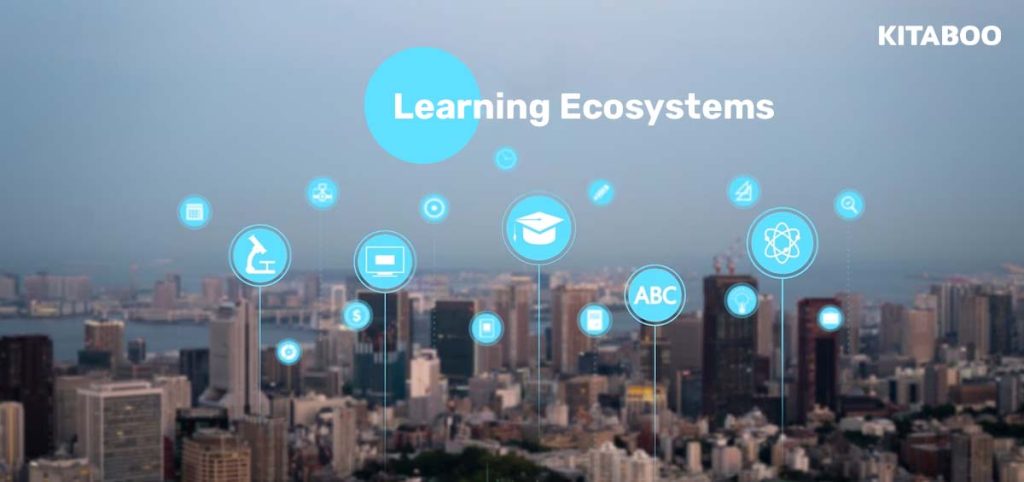
How to Build a Successful Learning Ecosystem as a Publisher?
Summarize this blog with your favorite AI:
Aided by rapid innovation and seamless adoption, digital technology has spearheaded transformations everywhere, including the publishing industry. There’s no denying that the publishing industry is becoming increasingly diverse, dynamic, and technology driven.
Developments like eBooks, digital publishing, artificial intelligence, etc., are leading the industry in a new direction. These innovative tools are helping publishers build successful learning ecosystems for organizations and institutions.
In this digital era marked by rapid innovation, businesses want to stay competitive, and employees want to stay relevant. Creating good learning ecosystems is essential to optimize resources and foster sustained business growth. This article provides insights about how to build a successful learning ecosystem.
Table of Contents
What Is a Learning Ecosystem?
A learning ecosystem is much like any complex biological ecosystem where different species and environments interact and depend on each other. However, a learning ecosystem involves people, their relationships, technology, content, culture, etc. All of these elements affect how people learn in an organization, whether through formal or informal training.
Like a thriving or struggling natural ecosystem, a learning ecosystem exhibits comparable dynamics. Achieving positive learning outcomes requires understanding and managing this ecosystem, considering internal and external influences. Let’s dive a little deeper.
Major Components of a Learning Ecosystem
A learning ecosystem is an integration of three key components. These include the following:
1. People
Learners are at the core of your publishing ecosystem. But beyond them, your ecosystem will have other stakeholders as well:
- Those who can impart knowledge in an ecosystem:
- Formally and professionally: managers, training instructors, experienced workers, etc.
- Informally: colleagues, family, friends.
- Those who benefit from developed learners and can measure their growth:
- Clients and customers.
2. Training Solutions
Training solutions or content is the next crucial element of your learning ecosystem, enabling you to leverage your workforce and reach your learning and development goals. However, this content can come from a variety of sources, given an ecosystem’s complex interactions:
- It can come from direct training through upskilling and reskilling courses or workshops with instructors. Digital textbook platforms like KITABOO can help organizations disseminate knowledge in an interactive and always accessible format.
- It can come from one-on-one meetings with managers and team leaders.
- It can come informally through conversations with colleagues, managers, peers, etc.
- It can be self-driven, where employees take courses outside the organization.
3. Technology
Technology is an essential aspect of a learning ecosystem. The right learning technology can be crucial in seamlessly developing and delivering training solutions, connecting all stakeholders to a common goal. Integrating the appropriate digital tools can build a successful learning ecosystem in the following ways:
- It provides easy access to training solutions for all learners, including those with disabilities or learning challenges.
- Technology can help collect feedback from learners and gather data on the efficacy of training modules, providing scope for improvement.
- Organizations can leverage digital tools like interactive eBooks, artificial intelligence, multimedia, etc., to significantly enhance learning outcomes.
- It can even be leveraged to inform and entice the end user, the customer.
How to Build a Learning Ecosystem?
To build a learning ecosystem, you must have a clear strategy and plan your moves accordingly. Further, you must have a deep understanding of your learners’ mindset
Here’s how you can create an efficient learning ecosystem as a publisher:
1. Determine Your Learning Goals
Every business has specific goals and objectives, and the learning ecosystem must be in tune with them. You need to be clear about how the new competencies of your employees can help your business. So, the first step is to determine the goals of your learning ecosystem. Let’s look at a scenario.
Suppose a business wants to expand into a new market in another country. You must develop a learning ecosystem localized to that market’s unique culture. This could involve localizing employee training material to avoid cultural faux pas and conduct effective training.
2. Opt for the Right Tools and Technology
To derive maximum advantage from the learning process, you must integrate technology. The right tools and technology can provide easy accessibility and promote continuous learning. Further, they can ensure that the learning suits each employee’s preferences.
Most importantly, technology can connect the various components of a learning ecosystem. Ensure to opt for tools that can engage your learners anytime and anywhere. Whether you want to provide multi-device-ready content or end-to-end training solutions, integrating technology with your LMS is the key.
Another factor to consider is performance tracking. When you opt for training solutions such as those provided by KITABOO, you can get insights into content consumption. This will enable you to measure your learners’ progress and customize the content to fit their needs.
3. Integrate Measures to Optimize Learning
It’s important to ensure that your learning ecosystem provides scope to analyze feedback and optimize learning. Once you have the metrics that reveal the content consumption habits of your learners, you need to identify the patterns. You can accumulate feedback about various aspects of the content, such as accessibility, ease of understanding, application, etc.
By analyzing relevant data, you can discover the practices that impact the learning experience the most. For instance, digital textbook platforms by KITABOO provide complete analytics about content consumption by learners. Such measures will help you to determine how effective your LMS is. At the same time, they will provide the scope to introduce changes and optimize employee learning.
4. Ensure Proper Coordination of Different Elements
As stated earlier, a learning ecosystem involves various elements. These components must act in complete coordination for an ecosystem to function seamlessly. They need to work as elements of a single environment.
For this, you need to concentrate on aligning learners, resources, and technology with the mission and vision of your business. This is where you need to assign specific responsibilities to various people within the ecosystem.
For instance, you can engage the L&D team to understand the strategy of the ecosystem and implement the learning tools. Train managers and supervisors to motivate learners to use the training solutions. You can gain actionable feedback from employees regarding the learning content.
Conclusion
Building a learning ecosystem involves various components that need to function as part of a single environment. But you can’t follow a one-ecosystem-serves-all policy. Each publishing organization needs to create a system that caters to its specific requirements. As such, it becomes essential to develop relevant content and training solutions.
If you are looking for a customized content and training solutions provider, you can contact KITABOO. It is an innovative digital textbook platform specializing in customized and secure content experiences.
To know more, please get in touch with contact@kitaboo.com.
Suggested Reads:
Discover how a mobile-first training platform can help your organization.
KITABOO is a cloud-based platform to create, deliver & track mobile-first interactive training content.



